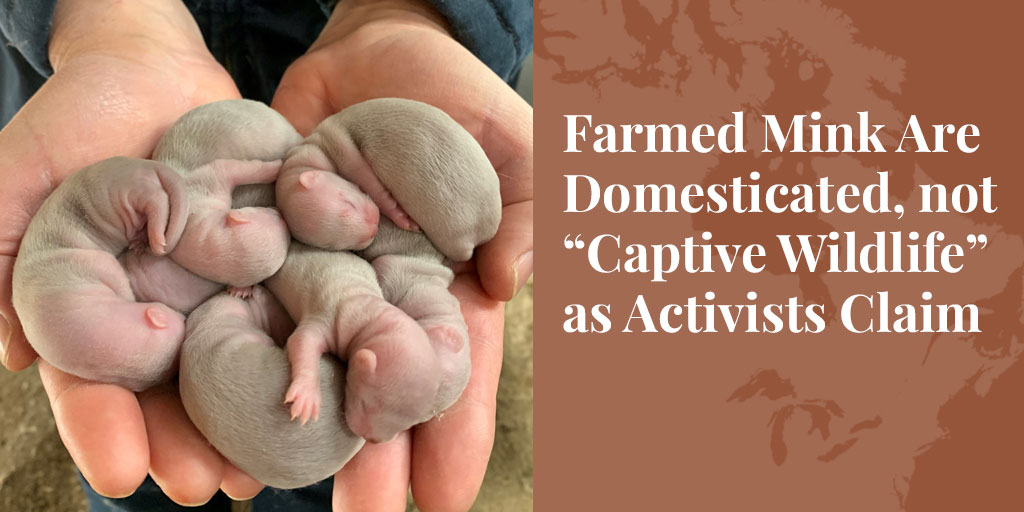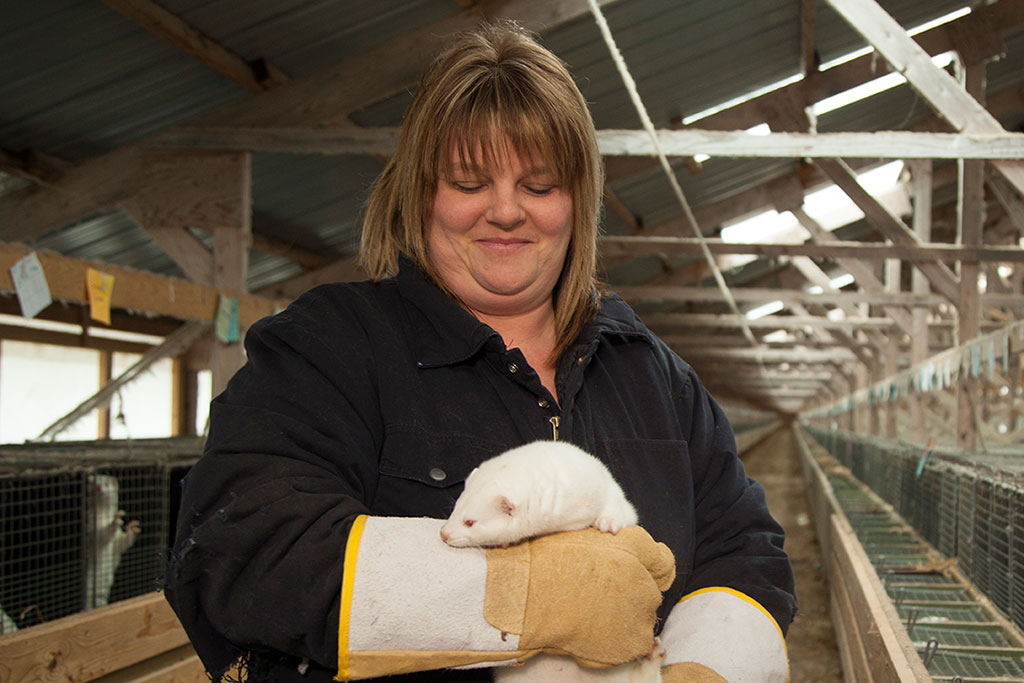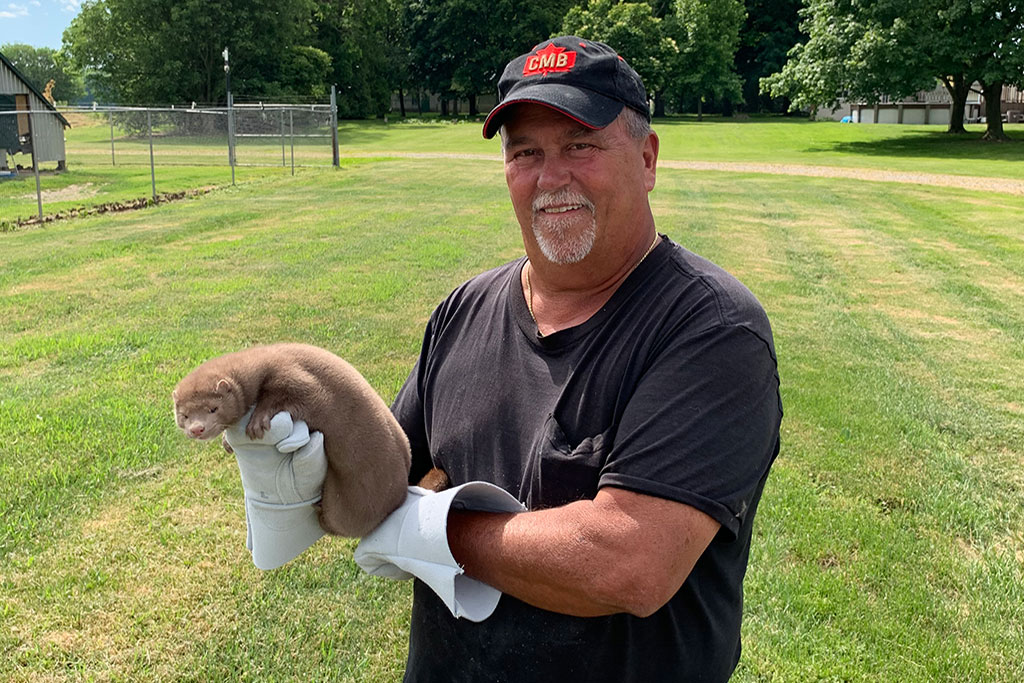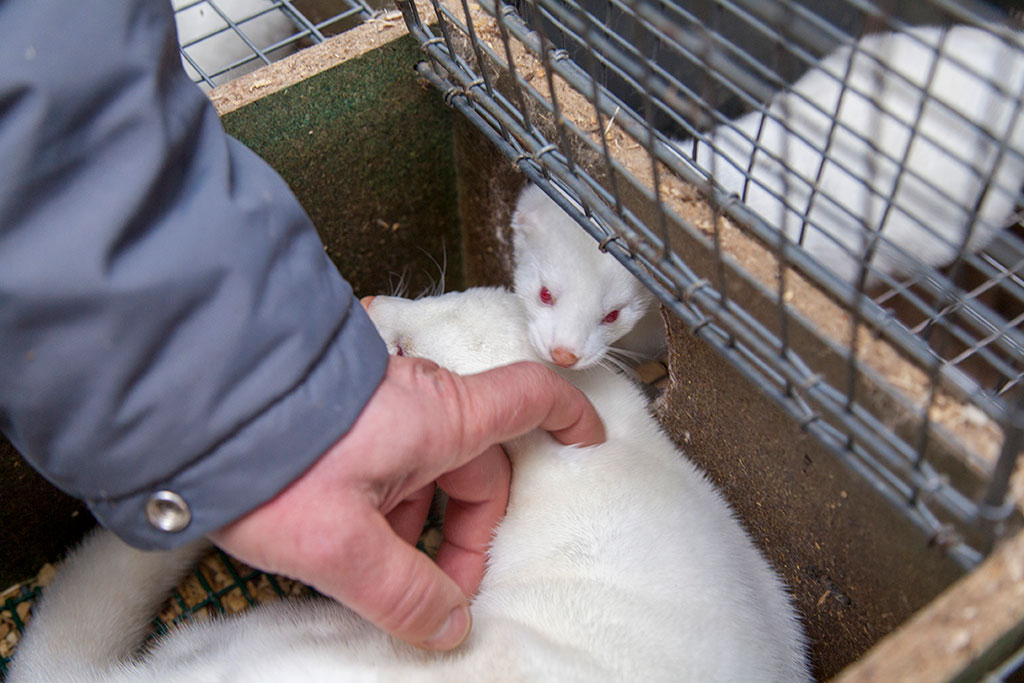
Raised by humans for more than 150 years, farmed mink are significantly different from their wild cousins and are now clearly domesticated, despite animal activist claims to the contrary. This is important because the claim that farmed mink are not domesticated, but rather are “wild animals kept in captivity”, sits at the heart of activists’ critique of mink farming.
Activists argue that, because wild mink travel and hunt over large territories, it is impossible to satisfy their fundamental needs on farms. Therefore, they claim, mink farming cannot be humane or ethical, and should be banned.
SEE ALSO: The ethics of fur. Truth About Fur.
But is it true that mink farmers are keeping “wild animals” in captivity?
To support their claim that farmed mink are wild, activists point out that they have been raised by humans for only a short time compared with cattle, chickens, pigs or other farm animals. As a result, they say, farmed mink maintain much of their “wildness” – often they can only be handled wearing gloves – and are “biologically unchanged”, so they can survive if released (accidentally or intentionally) into the wild, and can even interbreed with wild mink.
Let’s look more closely at each of these claims.
How Long Does Domestication Take?

It is true, of course, that mink have been raised by humans for much less time than many common farm animals. Mink were first bred and raised in captivity in North America as early as 1866, but the ancestor of our domestic chickens, the red junglefowl (Gallus gallus), was domesticated some 7,000 to 10,000 years ago in India and China. The domestic pig, derived from the Eurasian wild boar (Sus scrofa), dates from around the same time.
It is worth noting, however, that for most of their history, domesticated chickens, pigs, and other farm animals were raised mostly outdoors. The time these animals have been raised indoors, in more confined cages or pens, is not really that different from mink.
The more important question is how long is really required for an animal to become domesticated? And to answer that question, we must ask what domestication really means.
Animal scientists and biologists consider that domestication involves directional selection that produces morphological, physiological (or functional), and behavioural changes in the animal – changes that allow the animals to successfully adapt to husbandry conditions, and to better satisfy human needs.
Like other domesticated animals, selection for various traits in mink may be “active” (e.g., farmers selecting breeding pairs to develop new fur colours, or to produce larger animals with more fur per animal), or “passive” (e.g., physiological or behavioural changes that emerge because mink are no longer subjected to the natural selection pressures of finding food and mates, or avoiding predators).
Selection Brings Changes

Following are some of the changes observed in farmed mink that show they have, in fact, undergone a process of domestication through active and passive selection.
CHANGES IN SIZE AND PHYSIQUE
Such changes are a common result of domestication. For example, chihuahuas and bulldogs are very different from wolves. Similarly, farmed mink can be twice the size of wild mink – the result of many generations of selecting for larger animals that produce more usable fur per animal.
CHANGES IN FUR COLOUR
Many domesticated species of mammals and birds show a range of fur and feather colouration that is either rare or unknown in the wild. Wild mink are usually dark brown, but farmed mink have been selectively bred for a wide variety of consistent colour phases, ranging from pure white to jet black. Paler-coloured mink also tend to be larger than darker strains, and more docile.
CHANGES IN MUSCLE AND FAT FORMATION
Farmed mink have more subcutaneous fat than their wild cousins. This fat is rendered into mink oil, for waterproofing and conditioning leather. The increased fat appears to be a secondary effect of selecting for larger animals.
PHYSIOLOGICAL CHANGES
Farmed mink are fertile over a longer period than wild mink, and they also have larger litter sizes. Wild female mink produce an average of two to three kits, while farmed mink average five to six, and sometimes as many as 12. Farmers sometimes select breeding stock for larger litter size, but there is evidence that the (passive or active) selection for less aggressive behaviour (“docility”) may also result in increased fertility and larger litters.
CHANGES IN BRAIN SIZE
It is well known that the brain volume of domesticated animals is generally smaller than in the wild animals from which they are descended. This can range from a reduction in volume of about 14% in domesticated ducks and guinea pigs, to as much as 25-34% in sheep, pigs, dogs, cats, and ferrets. Similarly, when corrected for body size, the brains of farmed mink are about 20% smaller than those of their wild cousins. The heart and spleen of farmed mink are also smaller, which had also been observed in other domesticated animals. Reduced brain volume and other changes are likely the result of the removal of natural selection forces including the need to find food and flee predators.
CHANGES IN BEHAVIOUR AND TEMPERAMENT
While most farmed mink must still be handled with gloves, they are considerably less fearful or aggressive than wild mink – as anyone who has visited a farm can attest. When we enter a barn, most mink will come to the front of their pens to see who’s there; they show curiosity rather than fear or aggression. While farmers have selected mink mostly for size, fur colour and quality, and sometimes for litter size or maternal instinct, there is also a degree of active and passive selection for tameness. This is because highly fearful or aggressive animals do not thrive in a farm environment, are more difficult to handle, and may not reproduce as readily. The codes of practice for raising mink in both the US and Canada include provisions for selecting against fearfulness and abnormal behaviours (sterotypies). Increased fertility, larger body size, reduced brain volume, and certain paler colour phases are also correlated with increased tameness.
Animal Activist Arguments
This brief summary shows that farmed mink clearly exhibit a number of morphological, physiological and behavioural traits commonly associated with domestication. But what about the issues animal activists raise to argue that farmed mink are not domesticated?
For example, take what happens when animal activists raid a mink farm and release the animals. Usually they remain close by and are easily recaptured, if they are not killed by passing cars first. But some can survive in the wild, and even interbreed with wild populations. Activists cite this as “proof” that farmed mink are really “wild animals”, but we know that cats, pigs, and other indisputably domesticated species are also able to survive, and breed, in the wild. Dogs, for example, can interbreed with wolves and coyotes.
Activists also claim that wild mink are agile (hard to handle), carnivorous, solitary, and shy in nature, and therefore not good candidates for domestication. However, other carnivorous animals – like cats and ferrets (a close cousin of the mink) – are also agile, solitary and shy in the wild, but have clearly been domesticated.
When pressed, activists argue that mink simply have not been raised on farms long enough to be domesticated. But the experiment conducted by Dmitri Belyaev and Lyyudmila Trut, in Siberia, famously demonstrated that selecting for just one trait – tameness – in farmed silver foxes was sufficient to produce dramatic physiological changes and dog-like behaviours in only 20 generations. Mink have been raised on farms in North America for about 150 years – that’s 150 mink generations — more than enough time for active and passive selection to have induced changes normally accepted as domestication, as summarised in this article.
What Scientists Say

Much of the information in this brief summary is taken from two scientific papers: “Is the mink domesticated?” by Prof. Eddy Decuypere [Physiology Research Group, Faculty of Bioengineering Sciences, Catholic University of Leuven, 2005], and, “The welfare of farmed mink as compared to other farmed animals, and the question of domestication of farmed mink”, by Prof. B.M. Spruijt, [Animal Welfare Centre, Veterinary Faculty, Utrecht University, 1999]. Those interested in this subject would do well to consult these papers, as well as the extensive scientific references they cite to support their observations.
Prof. Spruijt concludes: “Farmed mink are surely a domesticated species, as evidenced by certain defined characteristics of domestication present in mink, like changes in fur colour, physiology and behavior brought about by selection.” While acknowledging that ”docility” is one aspect of domestication that seems less pronounced in mink (and that he thinks is worthy of further research), he reports that “Given the relatively short history of mink breeding, the welfare assessment of farmed mink suggests that mink have adapted reasonably well to captive conditions,” and that “Compared to the welfare of other farmed animals, there is no reason to suggest that their level of domestication presents an unacceptable welfare problem.”
Prof. Decuypere similarly concludes that, “based on a number of typical domestication characteristics such as changes in fur colour, the lengthening of the mating season, the reduction in brain volume and behaviour changes, and by analogy to changes in these characteristics in animals known to us from time immemorial, the bred mink is unmistakably a domesticated animal.”
It should be noted that while we have focussed on farmed mink in this survey, many of the same arguments for domestication – e.g., on-going selection for increased size, new colour phases, more docile temperament – can also be made for farmed foxes.
Of course, none of this will satisfy activists who subscribe to the extreme “animal rights” philosophy. For them, animal welfare concerns like those raised by the domestication debate are just a smokescreen, because they know that most people do not share their belief that humans have no right to use animals at all, for any purpose.
The claim that farmed mink are not domesticated animals is just the latest Trojan Horse that animal activists are wheeling out to insinuate their no-animal-use agenda onto consumers, the media, and politicians. Like so many activist claims, it is not supported by the facts.
***
To learn more about donating to Truth About Fur, click here.











Looking into biology and scientific definitions of what “domestication” supposedly is has made it seem like an incredibly imprecise, muddled term. They seem highly motivated to exclude all species of animals that weren’t incorporated into human society tens of thousands of years ago, or that don’t fit 21st century, middle class ideas of what would make a suitable pet. But there isn’t a good way to justify that by any objective, sensible measure, so you get complete wingnuttery like that proposed law in Spain that started out as something to rein in greyhound racing, and wound up asserting that it’s cruel to keep anything but a cat or a dog as a companion animal, because humans are just incapable of meeting these wild things’ needs properly. If it passed, guinea pig and rabbit owners would have had to prove they’d owned their animals before the law came into effect, and further prove they’d had them sterilized. Disturbing stuff.
Anyway – lay people seem to conceptualize domestication as whole species of animals that are “tame” and not considered dangerous to humans, but again, that definition breaks down the moment you consider how many humans per year are mauled by dogs, or the fact that all the large farm animals can and do sometimes kill people. Looking at what the US government has to say about it has also not helped at all – by official standards, a fox, raccoon, or a mink are farm animals if they’re being raised for fur, in my state, but “dangerous wild animals” and potential threats the second anyone tries to keep one as a pet. So, according to Russia, domestication isn’t a lost art, but according the America, no one knows how our ancestors did it and anything that might smell of that now is probably animal abuse or human endangerment. It’s beyond bizarre.
I’d like to be able to accept your argument, that an animal is domesticated if it is adapted to living in captivity without undue fear and stress, and has a body and temperament that reflects this. It admittedly makes a lot more sense than a lot of what I’ve seen so far. My main concern is that any human industry keeping an animal under any conditions, uninterfered-with, for not that many generations, could claim what they were doing was “good enough” just on account of their animals not being identical to their wild relatives (i.e. not getting frantic at the sight of humans when humans brought them food every day all their lives, for instance) and not croaking.
You’re right, of course, to realise that this is purely a semantic debate. To a large extent it’s been forced on society by animal rights groups, and we have all feel the need to respond in our own way. But there’s precious little science involved here. Personally, I find it useful to consider the symbiotic relationships between humans and some animal species like semi-wild chickens and a few dog species in SE Asia that are often adopted as family pets but are essentially wild. I’m not talking about feral domesticated dogs, but species that are wrongly identified as Canis familiaris when in fact they are related to Australia’s definitely wild dingo. These species represent a middle ground between wildness and domestication, while also serving to emphasise that it’s one huge grey area. But animal rights groups demand clear answers, so we try our best to provide them 🙂
Making it easier to enslave and kill an animal doesn’t suddenly make it justafiable. Domesticated, wild, doesn’t matter. They’re victimized either way.
God Almighty created this earth and its bounties including all farm animals for human beings and their needs. As long as there is a sustainable method and if a farmed specie is not endangered, there should not be any issue for consumption or use for skin for mankind. If your particular flavor of religion does not allow this, then please by all means abstain but do not make issue for others who are not forbidden either by religion, morally or due to an abundance of absence of a threat to a specie or species. Live and let others live.